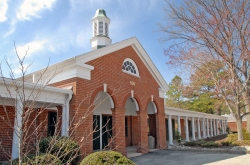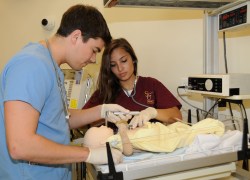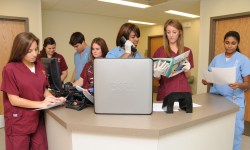$1 Million Gift Announced for Richard A. Henson Medical Simulation Center
|
|
SALISBURY, MD---Salisbury University officially opened its new Richard A. Henson Medical Simulation Center during a festive ribbon-cutting on Thursday, December 1. The ceremony was marked by the announcement of a $1 million gift for the center from the Richard A. Henson Foundation, Inc.
“Mr. Henson was a community benefactor and champion of higher education. I think he would have been an enthusiastic supporter of this project,” said SU President Janet Dudley-Eshbach. “We are grateful to the Henson Foundation for maintaining his vision and commitment to progress and innovation, particularly in the sciences.
“The campus footprint has changed drastically this fall. Today we have another example of a new and creative facility, made possible through partnerships. The center will enhance the University’s ability to provide excellent educational experiences for students and to serve the region which Dick Henson loved.”
Known as the founder of the commuter aviation industry, Henson first made an indelible mark on the campus with a multi-million dollar endowment of the Richard A. Henson School of Science and Technology in 1988. This was followed by a $1 million gift for new science equipment in 1998.
 “The Foundation was established by Mr. Henson to enrich the quality of life of the greater Salisbury area and to act as a catalyst for the betterment of the community,” said Chairman Jon Sherwell. “The trustees feel Salisbury University’s efforts to create this center truly embody his spirit, objectives and ideals.”
“The Foundation was established by Mr. Henson to enrich the quality of life of the greater Salisbury area and to act as a catalyst for the betterment of the community,” said Chairman Jon Sherwell. “The trustees feel Salisbury University’s efforts to create this center truly embody his spirit, objectives and ideals.”
Located at 106 Pine Bluff Road in Salisbury, the Richard A. Henson Medical Simulation Center serves students across disciplines, including nursing and health sciences, as well as community health providers. Under the guidance of faculty, they will have opportunities to practice potentially life-saving skills, often involving collaboration and teamwork, in a safe and regulated environment. Through simulation, they will develop evaluation and treatment techniques to best care for patients.
“For over 30 years, the University has been a leader in educating health care professionals who serve across the Eastern Shore and throughout the State of Maryland,” said Dr. Karen Olmstead, dean of the Henson School. “There has been a critical and growing need for high-quality clinical simulation experiences for students and practicing professionals. Salisbury’s ability to provide this has now been dramatically enhanced.”
 In 2010, the University received a $937,000 grant from the Maryland Hospital Association’s Who Will Care? Fund for Nurse Education to purchase simulation equipment and to support related programming. The SU Foundation, Inc., then partnered with the University to secure the facility. The redesign and renovation was led by Design Collective, Inc. of Baltimore and contractor Harper & Sons of Easton.
In 2010, the University received a $937,000 grant from the Maryland Hospital Association’s Who Will Care? Fund for Nurse Education to purchase simulation equipment and to support related programming. The SU Foundation, Inc., then partnered with the University to secure the facility. The redesign and renovation was led by Design Collective, Inc. of Baltimore and contractor Harper & Sons of Easton.
The $1.15 million building project is part of SU’s ongoing efforts to help reduce the national nursing shortage in the local area and beyond. Offering nearly 5,000 square feet of practical space, the center replicates a medical office, with a waiting room and nurses’ station. Featured are four specialized labs for LDRP (Labor, Delivery, Recovery and Postpartum), neonatal, pediatric and adult care. High-fidelity, computerized, life-like mannequins help replicate demanding and unpredictable clinical situations, allowing students to make real-time decisions and exposing them to a wide-range of conditions including premature births, diseases and physical injuries.
In a mental health wing, actors will serve as “patients” with various psychiatric issues to help students learn effective intervention techniques. Cameras throughout the facility will record student interactions for later critique by peers and faculty.
The center offers room for growth and expansion with, for example, the inclusion of lab space for future use by applied health physiology graduate students engaged in fitness, rehabilitation and sports performance analysis.
 “We envisioned a place where regional health care providers also are able to sharpen their clinical skills,” said Dr. Lisa Seldomridge, chair of the SU Nursing Department. “Learning never stops, especially in these professions, and SU is committed to providing top-notch, state-of-the-science education and training.”
“We envisioned a place where regional health care providers also are able to sharpen their clinical skills,” said Dr. Lisa Seldomridge, chair of the SU Nursing Department. “Learning never stops, especially in these professions, and SU is committed to providing top-notch, state-of-the-science education and training.”
The SU Nursing Department has the highest five-year average pass rate of all B.S.-granting institutions in Maryland on the National Council Licensure Examination. In 2010-11, its rate topped all other University System of Maryland campuses and Johns Hopkins University. SU offers Maryland’s only baccalaureate in respiratory therapy and only graduate program in applied health physiology. This year, the Medical Lab Science program increased its enrollment by 50 percent. Last year, 11 SU students were admitted to medical school and several others to professional programs in health fields. Starting in fall 2012, the University begins its first doctoral program, in nursing practice.
For more information call 410-543-6030 or visit the SU Web site at www.salisbury.edu.

